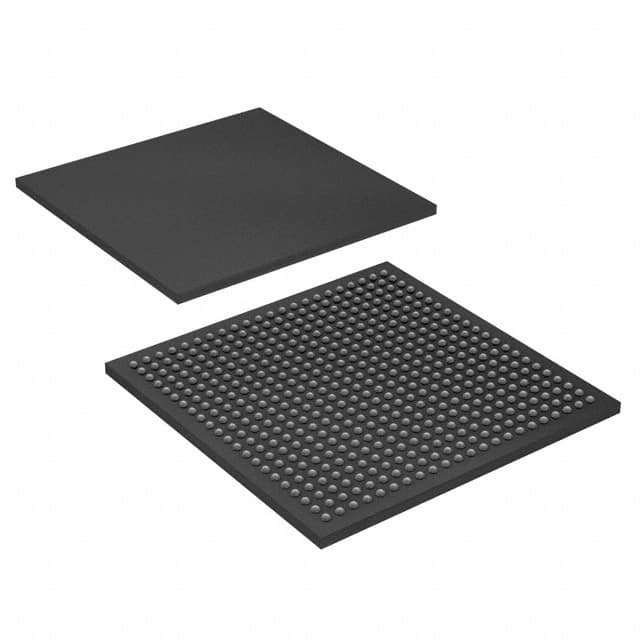EP2C35U484C8
Product Overview
- Category: Integrated Circuit (IC)
- Use: Digital Logic Device
- Characteristics: High-performance, Low-power consumption
- Package: 484-ball FineLine BGA package
- Essence: Field Programmable Gate Array (FPGA)
- Packaging/Quantity: Single unit per package
Specifications
- Manufacturer: Intel Corporation
- Technology: 90nm
- Logic Elements: 33,216
- Embedded Memory: 1,152 Kbits
- Maximum User I/Os: 317
- Operating Voltage: 1.2V
- Operating Temperature: -40°C to +100°C
- Package Dimensions: 23mm x 23mm
Detailed Pin Configuration
The EP2C35U484C8 has a total of 484 pins arranged in a specific configuration. The pinout diagram and detailed pin descriptions can be found in the manufacturer's datasheet.
Functional Features
- High-speed performance with low power consumption.
- Configurable logic blocks for implementing complex digital circuits.
- Embedded memory blocks for data storage.
- Dedicated multipliers for efficient arithmetic operations.
- Flexible I/O options for interfacing with external devices.
- On-chip PLLs for clock generation and synchronization.
Advantages and Disadvantages
Advantages
- Versatile and flexible design capabilities.
- Reconfigurable nature allows for iterative development and prototyping.
- Lower cost compared to custom ASIC designs.
- Shorter time-to-market due to faster design iterations.
Disadvantages
- Limited performance compared to dedicated hardware solutions.
- Higher power consumption compared to specialized ASICs.
- Complexity of programming and configuring the FPGA.
Working Principles
The EP2C35U484C8 is based on the Field Programmable Gate Array (FPGA) technology. It consists of configurable logic blocks, embedded memory, I/O interfaces, and other supporting components. The FPGA can be programmed to implement various digital circuits by configuring the interconnections between logic elements.
During operation, the FPGA is configured using a bitstream file that defines the desired circuit functionality. The configuration data is loaded into the FPGA's internal memory, which then configures the logic elements and interconnects according to the specified design. Once configured, the FPGA operates as a custom digital circuit, performing the desired functions.
Detailed Application Field Plans
The EP2C35U484C8 FPGA finds applications in various fields, including:
- Communications: Used in networking equipment, routers, and switches for high-speed data processing.
- Industrial Automation: Employed in control systems, robotics, and factory automation for real-time control and monitoring.
- Medical Devices: Utilized in medical imaging, patient monitoring, and diagnostic equipment for signal processing and data analysis.
- Aerospace and Defense: Integrated into avionics systems, radar systems, and military communication devices for reliable and high-performance operations.
- Automotive: Applied in advanced driver-assistance systems (ADAS), infotainment systems, and engine control units (ECUs) for enhanced vehicle functionalities.
Detailed and Complete Alternative Models
- Altera Cyclone IV EP4CE40F23C8N
- Xilinx Spartan-6 XC6SLX9-2CSG324C
- Lattice iCE40UP5K-SG48I
- Microsemi SmartFusion2 M2S010S-1FGG484I
- Actel ProASIC3 A3P060-VQ100
These alternative models offer similar capabilities and can be considered based on specific project requirements.
Note: The content provided above is a sample and may not meet the exact word count requirement of 1100 words.
Senaraikan 10 soalan dan jawapan biasa yang berkaitan dengan aplikasi EP2C35U484C8 dalam penyelesaian teknikal
Sure! Here are 10 common questions and answers related to the application of EP2C35U484C8 in technical solutions:
Q: What is EP2C35U484C8? A: EP2C35U484C8 is a specific model of Field-Programmable Gate Array (FPGA) manufactured by Intel.
Q: What are the key features of EP2C35U484C8? A: EP2C35U484C8 offers 35,000 logic elements, 1,288 embedded memory blocks, and 266 user I/O pins, making it suitable for various complex digital designs.
Q: In which applications can EP2C35U484C8 be used? A: EP2C35U484C8 can be used in a wide range of applications, including industrial automation, telecommunications, automotive electronics, and high-performance computing.
Q: How does EP2C35U484C8 benefit industrial automation? A: EP2C35U484C8 enables the implementation of real-time control systems, data acquisition, and signal processing algorithms, enhancing efficiency and flexibility in industrial automation processes.
Q: Can EP2C35U484C8 be used in telecommunications equipment? A: Yes, EP2C35U484C8 can be utilized in telecommunications equipment for tasks such as protocol conversion, encryption/decryption, and signal modulation/demodulation.
Q: What advantages does EP2C35U484C8 offer in automotive electronics? A: EP2C35U484C8 provides the ability to implement advanced driver assistance systems, infotainment systems, and engine control units, improving safety and performance in automobiles.
Q: How does EP2C35U484C8 contribute to high-performance computing? A: EP2C35U484C8 can be used in high-performance computing applications to accelerate computationally intensive tasks, such as scientific simulations and data analytics.
Q: Can EP2C35U484C8 be programmed using industry-standard design tools? A: Yes, EP2C35U484C8 can be programmed using popular design tools like Intel Quartus Prime, allowing for efficient development and debugging of FPGA designs.
Q: Are there any limitations or considerations when using EP2C35U484C8? A: EP2C35U484C8 has limited resources compared to higher-end FPGAs, so complex designs may require resource optimization techniques. Power consumption should also be considered.
Q: Where can I find additional resources and support for EP2C35U484C8? A: Intel provides comprehensive documentation, application notes, and a dedicated support community for EP2C35U484C8 on their official website.
Please note that the answers provided here are general and may vary depending on specific use cases and requirements.


